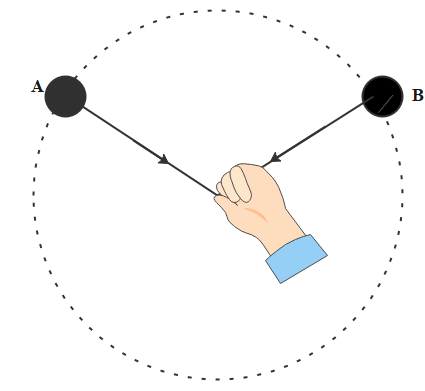
A boy is whirling a stone tied at one end such that the stone is in uniform circular motion. Which of the following statements is correct?

(A) The velocity of stone at A is equal to the velocity of stone B.
(B) The speed of stone at A is equal to the speed of stone at B.
(C) The centripetal force is radially outward in the string.
(D) All of the above statements are correct.

Answer
446.4k+ views
Hint: This type of question can be solved by analyzing the options given. By dealing with options carefully we will get to know which a proper answer statement is. Firstly, we will see what is the quantity that changes in uniform circular motion. Then, we will see the forces that maintain uniform circular motion and their properties. By doing this we will finally reach the conclusion.
Complete step by step answer:
We already know that in uniform circular motion, velocity being a vector quantity changes constantly as the direction keeps changing whereas speed remains constant in uniform circular motion.
Now, talking about centripetal force, it acts inwards towards the centre to balance the centrifugal force acting outwards from the center.
As velocity changes in uniform circular motion so option (A) is incorrect. Now, as centripetal force is acting inwards so, option (C) is incorrect. As (B), (C) are incorrect so, (D) is also incorrect.
So, the correct answer is “Option B”.
Note: Uniform circular motion- It is defined as the motion of the object in a circle at constant speed. It is a periodic motion with definite frequency and period. The condition of uniform circular motion is, the net force and acceleration is directed inwards. If centrifugal force is absent then, the object cannot move in a circular motion. The example of uniform circular motion can be the movement of blades in a windmill. In circular motion, the direction of velocity at a point is always along a tangent.
Complete step by step answer:
We already know that in uniform circular motion, velocity being a vector quantity changes constantly as the direction keeps changing whereas speed remains constant in uniform circular motion.
Now, talking about centripetal force, it acts inwards towards the centre to balance the centrifugal force acting outwards from the center.
As velocity changes in uniform circular motion so option (A) is incorrect. Now, as centripetal force is acting inwards so, option (C) is incorrect. As (B), (C) are incorrect so, (D) is also incorrect.
So, the correct answer is “Option B”.
Note: Uniform circular motion- It is defined as the motion of the object in a circle at constant speed. It is a periodic motion with definite frequency and period. The condition of uniform circular motion is, the net force and acceleration is directed inwards. If centrifugal force is absent then, the object cannot move in a circular motion. The example of uniform circular motion can be the movement of blades in a windmill. In circular motion, the direction of velocity at a point is always along a tangent.
Recently Updated Pages
Master Class 11 Economics: Engaging Questions & Answers for Success

Master Class 11 Business Studies: Engaging Questions & Answers for Success

Master Class 11 Accountancy: Engaging Questions & Answers for Success

Master Class 11 English: Engaging Questions & Answers for Success

Master Class 11 Computer Science: Engaging Questions & Answers for Success

Master Class 11 Maths: Engaging Questions & Answers for Success

Trending doubts
Which one is a true fish A Jellyfish B Starfish C Dogfish class 11 biology CBSE

State and prove Bernoullis theorem class 11 physics CBSE

1 ton equals to A 100 kg B 1000 kg C 10 kg D 10000 class 11 physics CBSE

In which part of the body the blood is purified oxygenation class 11 biology CBSE

One Metric ton is equal to kg A 10000 B 1000 C 100 class 11 physics CBSE

Difference Between Prokaryotic Cells and Eukaryotic Cells




